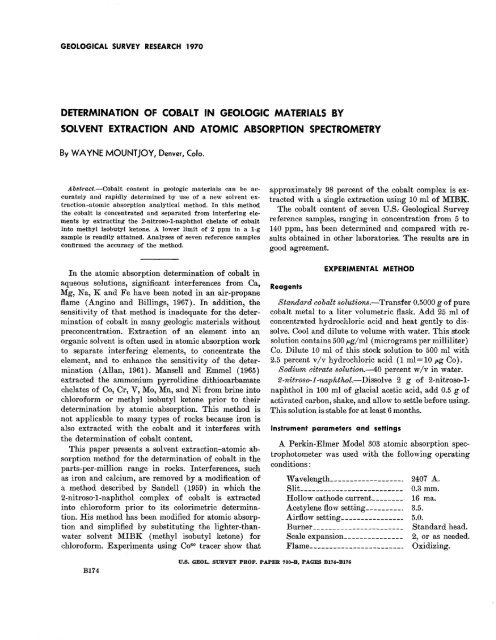RESEARCH· ·1970·
RESEARCH· ·1970·
RESEARCH· ·1970·
You also want an ePaper? Increase the reach of your titles
YUMPU automatically turns print PDFs into web optimized ePapers that Google loves.
GEOLOGICAL SURVEY RESEARCH 1970<br />
DETERMINATION OF COBALT IN GEOLOGIC MATERIALS BY<br />
SOLVENT EXTRACTION AND ATOMIC ABSORPTION SPECTROMETRY<br />
By WAYNE MOUNTJOY, Denver, Colo.<br />
Abstract.-Cobalt content in geologic materials can be accurately<br />
and rapidly determined by use of a new solvent extraction-atomic<br />
absorption analytical method. In this method<br />
the cobalt is concentrated and separated from interfering elements<br />
by extracting the 2-nitroso-1-naphthol chelate of cobalt<br />
into methyl isobutyl ketone. A lower limit of 2 ppm in a 1-g<br />
sample is readily attained. Analyses of seven reference samples<br />
confirmed the accuracy of the method.<br />
In the atomic absorption determination of cobalt in<br />
aqueous solutions, significant interferences from Ca,<br />
Mg, Na, K and Fe have been noted in an air-propane<br />
flame (Angino and Billings, 1967). In addition, the<br />
sensitivity of that method is inadequate for the determination<br />
of cobalt in many geologic materials without<br />
preconcentration. Extraction of an element into an<br />
organic solvent is often used in atomic absorption work<br />
to separate interfering elements, to concentrate the<br />
element, and to enhance the sensitivity of the determination<br />
(Allan, 1961). Mansell and Emmel ( 1965)<br />
extracted the ammonium pyrrolidine dithiocarbamate<br />
chelates of Co, Cr, V, Mo, Mn, and Ni from brine into<br />
chloroform or methyl isobutyl ketone prior to their<br />
determination by atomic absorption. This method is<br />
not applicable to many types of rocks because iron is<br />
also extracted with the cobalt and it interferes with<br />
the determination of cobalt content.<br />
This paper presents a solvent extraction-atomic absorption<br />
method for the determination of cobalt in the<br />
parts-per-million range in rocks. Interferences, such<br />
as iron and calcium, are removed by a modification of<br />
a method described by Sandell ( 1959) in which the<br />
2-nitroso-1-naphthol complex of cobalt is extracted<br />
into chloroform prior to its colorimetric determination.<br />
His method has been modified for atomic absorption<br />
and simplified by substituting the lighter-thanwater<br />
solvent MIBK (methyl isobutyl ketone) for<br />
chloroform~ Experiments using Co 60 tracer show that<br />
approximately 98 percent of the cobalt complex is extracted<br />
with a single extraction using 10 ml of MIBK.<br />
The cobalt content of seven U.S: Geological Survey<br />
reference samples, ranging in concentration from 5 to<br />
140 ppm, has been determined and compared with results<br />
obtained in other laboratories. The results are in<br />
good agreement.<br />
Reagents<br />
EXPE.RIMENTAL METHOD<br />
Standard cobalt solutions.-Transfer 0.5000 g of pure<br />
cobalt metal to a liter volumetric flask. Add 25 ml of<br />
concentrated hydrochloric acid and heat gently to dissolve.<br />
Cool and dilute to volume with water. This stock<br />
solution contains 500 pg/ml (micrograms per milliliter)<br />
Co. Dilute 10 ml of this stock solution to 500 ml with<br />
2.5 percent v/v hydrochloric acid (1 ml=10 pg Co).<br />
Sodium citrate solution.-40 percent w /v in water.<br />
~-nitroso-1-naphthol.-Dissolve 2 g of 2-nitroso-1-<br />
naphthol in 100 ml of glacial acetic acid, add 0.5 g of<br />
activated carbon, shake, and allow to settle before using.<br />
This solution is stable for at least 6 months.<br />
Instrument parameters and settings<br />
A Perkin-Elmer Model 303 atomic absorption spectrophotometer<br />
was used with the following operating<br />
conditions :<br />
Wavelength___________________ 2407 A.<br />
Slit__________________________ 0.3 mm.<br />
Hollow cathode current_ ______ _ 16 rna.<br />
Acetylene flow setting _________ _ 3.5.<br />
Airflow setting _______________ _ 5.0.<br />
Burner ______________________ _<br />
Standard head.<br />
Scale expansion ______________ _ 2, or as needed.<br />
Flame _______________________ _<br />
Oxidizing.<br />
B174<br />
U.S. GEOL. SURVEY PROF. PAPER 706-B, PAGES B174-B176
















